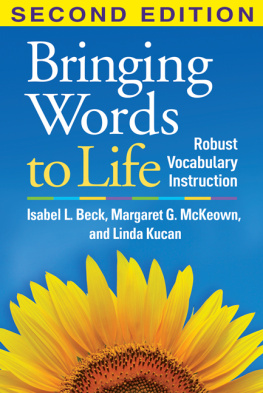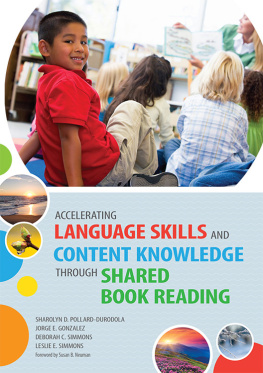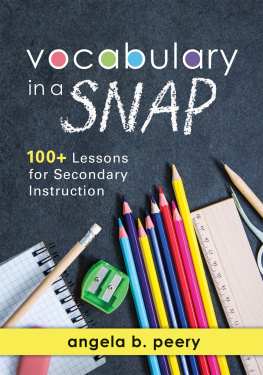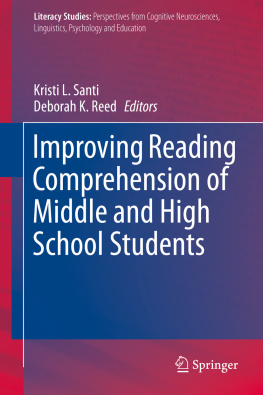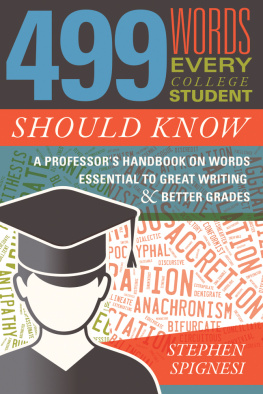Also from Isabel L. Beck, Margaret G. McKeown,
and Linda Kucan
Creating Robust Vocabulary:
Frequently Asked Questions and Extended Examples
Isabel L. Beck, Margaret G. McKeown, and Linda Kucan
Making Sense of Phonics:
The Hows and Whys
Isabel L. Beck
Bringing Reading Research to Life
Edited by Margaret G. McKeown and Linda Kucan
Bringing
Words to Life
Robust Vocabulary Instruction
SECOND EDITION
Isabel L. Beck
Margaret G. McKeown
Linda Kucan

THE GUILFORD PRESS
New York London
EPUB Edition ISBN: 9781462508266; Kindle Edition ISBN: 9781462508273
2013 The Guilford Press
A Division of Guilford Publications, Inc.
370 Seventh Avenue, Suite 1200, New York, NY 10001
www.guilford.com
All rights reserved
Except as indicated, no part of this book may be reproduced, translated, stored in a retrieval system, or transmitted, in any form or by any means, electronic, mechanical,
photocopying, microfilming, recording, or otherwise, without written permission from the publisher.
Last digit is print number: 9 8 7 6 5
LIMITED DUPLICATION LICENSE
These materials are intended for use only by qualified professionals.
The publisher grants to individual purchasers of this book nonassignable permission to reproduce the Study Guide on pages 195208. This license is limited to you, the individual purchaser, for personal use only. This license does not grant the right to reproduce these materials for resale, redistribution, electronic display, or any other purposes (including but not limited to books, pamphlets, articles, video- or audiotapes, blogs, file-sharing sites, Internet or intranet sites, and handouts or slides for lectures, workshops, or webinars, whether or not a fee is charged). Permission to reproduce these materials for these and any other purposes must be obtained in writing from the Permissions Department of Guilford Publications.
Library of Congress Cataloging-in-Publication Data
Beck, Isabel L.
Bringing words to life : robust vocabulary instruction / Isabel L. Beck,
Margaret G. McKeown, Linda Kucan.2nd ed.
p. cm.
Includes bibliographical references and index.
ISBN 978-1-4625-0816-7 (pbk.)ISBN 978-1-4625-0824-2 (hardcover)
1. VocabularyStudy and teaching. I. McKeown, Margaret G.
II. Kucan, Linda. III. Title.
LB1574.5.B43 2013
372.44dc23
2012030160
Isabel L. Beck, PhD, is Professor Emerita of Education in the School of Education at the University of Pittsburgh. She has conducted research and published widely in the areas of decoding, vocabulary, and comprehension. Her contributions have been acknowledged by awards from the International Reading Association, the National Reading Conference. and the American Federation of Teachers. Most recently she was elected to the National Academy of Education.
Margaret G. McKeown, PhD, is Clinical Professor of Education in the School of Education and a Senior Scientist at the Learning Research and Development Center, both at the University of Pittsburgh. Her research on reading comprehension and vocabulary has been published extensively in outlets for both researcher and practitioner audiences. Dr. McKeown is a recipient of the Dissertation of the Year Award from the International Reading Association and a National Academy of Education Spencer Fellowship. Before her career in research, she taught elementary school.
Linda Kucan, PhD, is Associate Professor in the Department of Instruction and Learning at the University of Pittsburgh School of Education. In addition to vocabulary instruction, her research includes work related to classroom talk about texts and motivating tasks to support comprehension of text. Dr. Kucan has published her work in both scholarly and practitioner-oriented outlets. She is coauthor with Annemarie Palincsar of Comprehension Instruction Through Text-Based Discussion, a book and DVD set.
O ur editor called us more than a year ago to point out that Bringing Words to Life (BWTL) would soon be 10 years old. We suspected that he was telling us this because on several occasions he had hinted that it would soon be time for a second edition. Each of us had different thoughts about the potential request.
Isabel Beck mused that when her 9-year-old grandchild turned 10, the family wouldnt be thinking of a second edition. Linda Kucans thoughts left no question of where she stood: My students love the book. Why mess around with something thats working? Margaret McKeowns reaction was: Ten years old? I have cheese in my refrigerator older than that!
Another phone call from our editor confirmed what we had suspected. He wanted a second edition. This time, our thoughts were virtually identical. No. Of course we were more considerate than that, and voiced our hesitations: no time, not on any of our agendas, and mostly we didnt know why a second edition was needed. Our editor astutely told us that a second edition wasnt like writing a whole new book. Moreover, he made the point that he was not in any hurry and just hoped we would take some time to think about it.
For a while, none of us gave our editors request any thought. However, eventually one of us pointed out to the others that it really wasnt fair. After all, we had said we would think about it. So we met as a group and decided to go through several chapters in order to evaluate them, that is, think about what we might change, eliminate, or add in the future to a new edition that we might want to do at the right time, but not now.
So we started with and did a kind of two-step: skim a chapter and talk about it, skim a chapter and talk about it; more talking than skimming. And as we went along we found things that we might change, if we were doing a new edition of the book, which, of course, we were not. One of us mentioned that we were making some important points and offering some good ideas, and another said she would take good notes for a future edition.
In knowing a little more about it than we had originally offered. Moreover, we talked about theory that was not available at the time of the first edition and that we certainly would want to include in a second edition. We also saw that too little information had been given directly about our three-tier framework and, were we planning a new edition, which we were not, we would make the discussion of tiers more prominent.
Our summary of , but our lives were such that we just could not.
We sampled several other chapters and saw lesser or greater things that should be included, elaborated, better explained, and the like. All of our discussion interested us; we were getting tempted, but we didnt want to act too rashlythat is, call our editor and say yes. When, however, we began talking about what topics were missingvocabulary and writing, struggling readers, English learnersthat was it. We knew that we had to write a second edition. And so we called our editor and said yes! This second edition is the consequence of that yes.
Let us tell you concretely, albeit briefly, about what you will find in the new BWTL. Returning to .
Now to what you will find in is almost twice as long as the first version: 4,732 to 8,391 words.
In is about 1,000 words longer than the earlier one: 4,894 to 5,750.
The current , which deals with robust instruction for young children, starts with a new section that was not available at the time of BWTLs first publicationseveral empirical research studies that looked at the effects of robust instruction on young students knowledge and use of Tier Two words. The rest of the chapter deals with the details of robust instruction: introducing target words and following up with those words for several days beyond their introduction for young learners. After the publication of BWTL, we heard from teachers that they loved the examples, but wanted more. Thus, this chapter is now rich with examples. The chapter is more than 2,000 words longer than the earlier version: 7,219 to 9,298.

